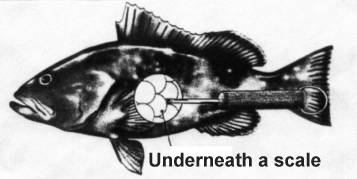Included in your packet is a venting tool. This tool is to be used on fish which are showing classic signs of swimbladder rupture which includes everted stomach, protruding intestines, bulging eyes and
bloating. If a fish appears to be normal (not bloated and able to swim down on its own) then venting is not necessary.
Venting procedure
To vent hold the fish gently but firmly on its right side  and insert the venting tool at a 45 degree angle at the base of the
pectoral fin. Only insert the tool deep enough to release gases, do not skewer the fish! The sound of escaping gas is audible and deflation is noticeable. If a fish is extremely bloated, use a free hand to exert gentle
pressure on the fish's abdomen to aid deflation.
and insert the venting tool at a 45 degree angle at the base of the
pectoral fin. Only insert the tool deep enough to release gases, do not skewer the fish! The sound of escaping gas is audible and deflation is noticeable. If a fish is extremely bloated, use a free hand to exert gentle
pressure on the fish's abdomen to aid deflation.
Return the fish to water as son as possible. If the fish requires resuscitation, revive it by holding the head pointed downward and move the fish back
and forth to pass water over the gills until the fish is able to swim unassisted. The tool needs to be regularly cleaned. Use a a piece of wire for clogs and chlorine bleach to disinfect after every use. Be sure to keep the cap on
when not in use to prevent personal injury.